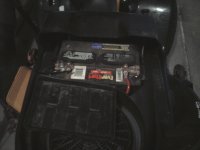The machine is about 10 years old I believe. It has a B&S 19HP turbocool engine.
I had posted an article a week ago or so about the battery losing charge overnight. Turns out this isn't it.
I had the battery load tested at 2 different shops, and it checked out. Voltage checks out good when sitting, cranking, and whenever the engine is running.
What the machine is doing: When I crank it over, it will turn 1 or 2 revolutions, stop, and then start clicking until you let go of the key. If you try it immediately after a few times, it will only move the flywheel just slightly, and than click again until you stop holding the key over. If you walk away and let the machine sit for an hour or so, the battery recovers slightly and it will give a few revolutions again, but will not take off running. I picked up a battery charger today, it was on sale and I figured it's easier to boost with it (has a 100 amp engine start feature) than to keep hauling out cables and boosting from vehicles. I hooked it up to the battery, it charged for 30 seconds and than gave me the green light, charge complete, haha. Funny enough, after that 30 second charge at 2 amps, it started, figure that one out!
The last 12 days the machine has started each time I have gone to use it, now it is back to failing me each morning.
I removed the covers on the engine today so I could see what the starter does when the key is turned. When I tried to start the machine, the gear on the starter came up like normal, but since the machine did not start, the gear would not go back down. Shouldn't this gear go down, even if the machine did not start? When I can get the machine started, the gear goes down every time.
I had an issue with hydraulic lock 2 months ago, but I rebuilt the carb and changed the oil and fixed that problem. Just to cover my bases, I removed the spark plugs and cranked the engine to let the compression escape. Even in this case, the engine turns, but quickly starts to slow down as if the battery is dead.
My only two guesses left are:
1. Starter Solenoid.
2. Starter itself.
Well...any ideas?
Thanks!
